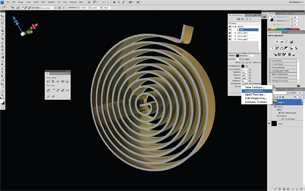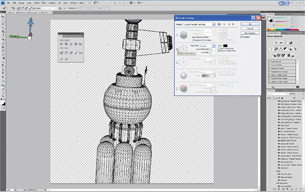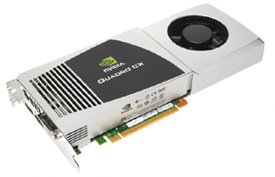Adobe Photoshop CS4 Extended Improves Flow
The latest version is a strong upgrade with plenty of new features for transforming your rendering and navigating your scene.
Latest News
June 30, 2009
By Mark Clarkson
 Photoshop CS4 provides transparency, volume, and ray-traced reflections as well as shadows on any 3D object you can design. |
In the nearly two decades since its release, Adobe’s Photoshop has become the definitive image-editing program—an application so ubiquitous, it’s become a verb. Does Adobe have anything left to add? I found out.
A New Look
There are significant changes to the Photoshop UI, but nothing disorienting. The improved Screen Mode button has been moved to the top of the interface, for example, next to the new Rotate View control and a much-needed Arrange Documents tool.
Layer masks now have interactive, non-destructive controls for density and feathering. And adjustment layers are easier than ever to use (and if you don’t use adjustment layers, I’m frowning at you right now!)
Photoshop CS4 sports de rigueur tabbed documents that greatly facilitate flipping through a dozen photos. You can tear a tab off and float the document free from the rest of the Photoshop interface, even moving it to a different monitor.
OpenGL Acceleration
In a trend we’re seeing everywhere, Photoshop CS4 is making use of GPU hardware acceleration, although it’s not offloading computational tasks such as filters just yet. For now, CS4’s OpenGL acceleration is largely limited to 3D (about which there will be more later) and moving around in large images—specifically zooming and panning, both of which have been subtly yet radically reformed.
With GPU acceleration, zooming is continuous. Click with the Zoom tool and you can zoom smoothly in or out, instead of jumping between discrete zoom levels as was the case.
 Photoshop CS4 imports 3D objects, complete with textures. Objects can be displayed as solids, lines, or points. |
You can “flick pan” documents: give them a little shove and they continue sliding smoothly across the screen before slowing to a stop.
Best of all is the new Birds-eye View tool, which allows you to flip back and forth between zoomed-in and zoomed-out views and easily navigate around the largest images. Like many past Photoshop features, these seem gratuitous until you’ve worked with them for a while; then you find you just can’t live without them.
Content-Aware Scaling
One of the coolest new technologies in CS4 is content-aware scaling, which intelligently scales your images, stretching and squashing less important pixels (say, trees and sky in the background) while preserving more important pixels, such as a group of people in the foreground. You also can manually protect certain areas of the image to help the process out.
3D, Now More than Ever
CS4, like CS3 before it, allows you to import 3D objects (3DS, OBJ, U3D, KMZ, and COLLADA) as well as 2D images. 3D objects appear with their full complement of maps, editable just like any other Photoshop documents. With CS4, you can now paint directly on models, creating and modifying texture maps with Photoshop’s standard tools: the brush, pencil, clone stamp, and so forth.
Photoshop isn’t the best place to work on your 100-million-poly airplane, but for small and medium models it works pretty well. I’ve pulled in OBJ files in excess of a million polygons and, while things got a bit chunky, it definitely works.
CS4 now lets you create a few basic 3D objects within Photoshop itself, including cylinders, boxes, pyramids, soda cans, and hats. You can also elevate 2D layers to 3D ‘postcards’ similar to the 3D layers found in Adobe After Effects. You’ve always been able to distort 2D layers to provide the illusion of 3D perspective, but 3D postcards are actual 3D layers. They can reflect the environment, cast and receive shadows, and so forth, as well as spin, scale, and move in 3D space.
Photoshop will render 3D objects, imported and created, with ray-traced reflections, refractions, and shadows. You can apply texture maps (colors, images) and bump maps. You can change materials’ brightness, reflectivity, shininess, and add and subtract lights.
|
NVIDIA Quadro CX The CX is a dual-width PCIe card, with dual DisplayPorts and a single DVI connector. The entire card sits in its own enclosure pierced by a fan on one side to control airflow. It’s really a three-slot card, as any card placed directly above it will be about 1/8 in. from the exhaust fan, and will soon become the temperature of molten lead (the card draws 150W). If you’ve got six slots free, the CX supports SLI allowing you to link two of the cards together. The CX is promoted by NVIDIA as the CS4 Suite accelerator and, with 192 full-precision 64-bit floating-point processors and 1.5GB of fast GDDR3 RAM, it accelerates the heck out of things. The difference between Photoshop CS4 with and without GPU acceleration is like the difference between hopping in the street with your ankles bound and rolling down the avenue in a red convertible. Huge photos (400 megapixels+) were smooth as glass. This speed isn’t exclusive to the CX—any GPU-accelerated card will take advantage of Photoshop’s new features; they’re implemented via OpenGL, after all. A lot of the CX’s value comes from the rest of the CS4 suite, especially its hardware acceleration of H.264 video encoding in Adobe Premiere and After Effects. If you don’t work with video, consider the Quadro FX 4800 instead; essentially the same card, it sells for a few hundred dollars less. — MC |
A 3D-axis tool in one corner provides you with colored, visual cues as to your object’s orientation. You can easily scale, rotate, and move your objects with this one intuitive widget. Photoshop also gives you individual tools for transforming your object and navigating your scene.
Still, I find Adobe’s 3D navigation a bit awkward, probably only because I’m used to working in “real” 3D apps. I doubt Photoshop’s 3D workflow will ever be as optimized as, say, 3ds Max or SolidWorks.
Configurator
While it is not actually a part of Photoshop, Configurator is a fascinating little application available via free download from Adobe Labs. Configurator allows you to easily create your own panels and palettes for Photoshop CS4. You can drag and drop tools, menu items, Photoshop actions, and text. What’s more, you can drop in images, audio, video, and even SWF and FLV movies and animations. And all of this goes beyond the usual customizable tool palettes many of us have used.
You could, for example, create a panel that guides users through a standard process—such as preparing photographs for printing—complete with carefully organized tools, actions, text hints, and even animated tutorials or videos. All the images, animations, and video are referenced via URL; you’re not embedding a 2MB tutorial video within the actual panel.
Help Me!
Like that of most big applications, Photoshop’s help has gone online. Selecting Help from the menu takes you to the Web where you’re hooked into help, community forums, and the Adobe knowledge base.
This works pretty well, but sometimes the trees seem to get lost in the forest, and you’ll find yourself searching through a list of discussion threads rather than the help entry you’d hoped for.
The new 3D features deserve more space than they’re given. Reflective surfaces reflect the environment map, but where do you set the environment map? Help never says.
The Verdict
If you regularly work with very large images and you have a newer video card, you’ll definitely find this upgrade worth it. Likewise it’s worth it if you’d like to integrate Photoshop (MSRP $999; upgrades from $349) more tightly with your 3D workflow, or create your own panels.
Otherwise, this is still a strong upgrade with an improved workflow and plenty of new features I haven’t touched on, though older machines—especially those with older video cards—may balk a bit.
Go ahead and give it a try. You can download a trial version of Photoshop and all Adobe’s applications from adobe.com/downloads/
More Info:
Adobe Photoshop CS4
Adobe Systems, Inc.
San Jose, CA
NVIDIA Corporation
Santa Clara, CA
Contributing Editor Mark Clarkson, a.k.a. “the Wichita By-Lineman,” has been writing about all manner of computer stuff for years. An expert in computer animation and graphics, his newest book is “Photoshop Elements by Example.” Visit him on the web at markclarkson.com or send e-mail about this article c/o [email protected].
Subscribe to our FREE magazine, FREE email newsletters or both!
Latest News
About the Author
Mark ClarksonContributing Editor Mark Clarkson is Digital Engineering’s expert in visualization, computer animation, and graphics. His newest book is Photoshop Elements by Example. Visit him on the web at MarkClarkson.com or send e-mail about this article to [email protected].
Follow DE






